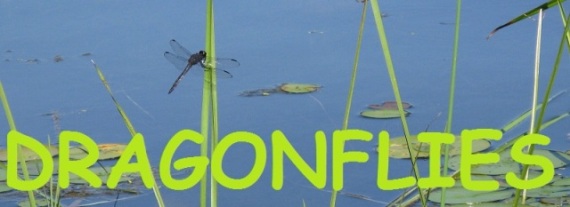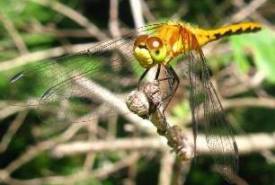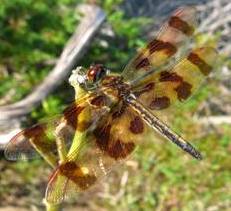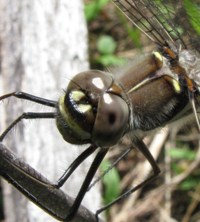

Have you ever seen a dragonfly perched in the sun on a dead tree branch, or maybe zipping by over the surface of a pond or stream? Because they are fairly large insects and because of their presence in almost every wetland it makes them easy to observe as they hunt their prey and patrol their area, and search for mates.
 Dragonflies are members of the insect order Odonata. This group of insects have inhabited the earth for more than 250 million years! That means dragonflies were around when there were dinosaurs. But they were much bigger then; there have been fossils found that prove that some dragonflies had wingspans up to two and a half feet. That's longer than your arm!
Dragonflies are members of the insect order Odonata. This group of insects have inhabited the earth for more than 250 million years! That means dragonflies were around when there were dinosaurs. But they were much bigger then; there have been fossils found that prove that some dragonflies had wingspans up to two and a half feet. That's longer than your arm!
Dragonflies are found all over the world. Ponds and lakes, rivers and streams, bogs, swamps and marshes are the places that these insects call home.

A dragonfly's wings may look thin and fragile, but they are actually very tough and flexible. Dragonflies' two sets of transparent wings beat at about 30 beats per second so they can fly at an impressive speed, but they are also able to hover in one spot, fly backwards or sideways, and snatch their prey right out of the air! Dragonflies rest with their wings held open at their sides. Dragonfly wings can be clear or colored and sometimes they have white, black or brown spots or bands.

Dragonflies have very big eyes for the size of their head. Their compound eyes have up to 30,000 tiny lenses in each eye which makes them very useful for pinpointing fast moving prey or predators, while standing still or flying fast. Another advantage of compound eyes is that it allows the dragonfly to see in almost all directions at the same time without even moving their head!
Like all other insects, dragonflies have six legs. An interesting fact about dragonflies is that their legs are great for capturing their prey, however, they are not strong enough for walking. They are also used for standing on plants or branches while they rest.

Dragonflies feed on a variety of insects, like flies, mosquitoes, butterflies, moths or even other dragonflies and damselflies. Dragonflies usually catch these flying insects right in the air using the basket they form with their legs. Sometimes they hunt in groups when there are swarms of insects, like mosquitoes. Dragonflies are able to eat equal to their own weight in about half an hour!

Although they are predators themselves, dragonflies are often hunted by snakes, lizards, birds, frogs, fish and other animals or they may even fall prey to other insects including larger dragonflies. They are often caught in mid-air by birds. They can also become the meals for spiders when they get trapped in a spider web.
 A dragonfly nymph crawls form the water before its final molt
A dragonfly nymph crawls form the water before its final moltThe dragonfly life cycle begins with an egg deposited by the female in the water or on aquatic plants. The larvae emerge from the eggs and live and grow underwater, breathing through gills, eating aquatic insects, and sometimes worms, snails, tadpoles and even small fish! As they grow they shed their skins or exoskeleton, this is called molting. They molt many times before being ready to become adults. Dragonflies go through an incredible metamorphasis. They leave their underwater world, molt one more time, and then take to the air as agile flying insects.
Even after emergence has taken place, over the next week or so the exoskeleton of the juvenile dragonfly continues to become hardened and pigmented (colored). So adults are usually more brightly colored than the juveniles, and the mature males are often more brightly colored than the females, which can make it more difficult to figure out what species you have.
Usually adult dragonflies only live for two to four weeks with the exception of some tropical species and migrating species.
You can read more about dragonflies on our Odonata page.
If you would like to check out some different species of dragonflies in Ontario, Canada then click here: Some Dragonflies and Damselflies of Ontario, Canada
Also check out these other websites for more information:
Dragonfly and Damselfly Classification & Ecosystem Info
Odonata Central